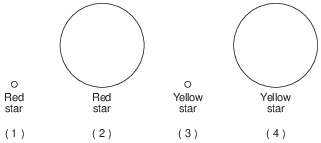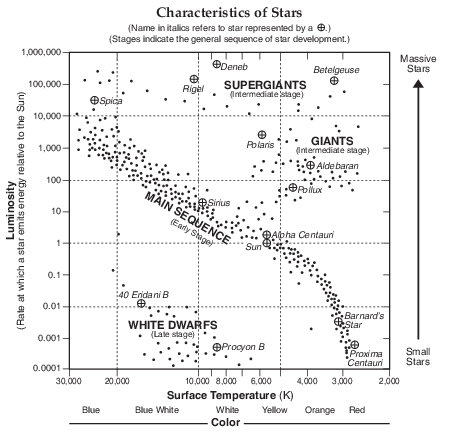Topic: Characteristics Of Stars
Characteristics Of Stars
The diagram below represents a model of the size of the Sun and indicates the color of the Sun.

Which diagram best represents the relative size and indicates the color of Polaris compared to the Sun?

(1) 1
(2) 2
(3) 3
(4) 4
The altitude of Polaris measured by an observer at the Tropic of Cancer is
(1) 15°
(2) 23.5°
(3) 66.5°
(4) 90°
Compared to the Sun, the star Betelgeuse is
(1) less luminous and warmer
(2) less luminous and cooler
(3) more luminous and warmer
(4) more luminous and cooler
The star Vega has an average surface temperature of 10,000 K and has a luminosity 70 times greater than that of the Sun. Which type of star is Vega?
(1) supergiant
(2) giant
(3) white dwarf
(4) main sequence
Which star is cooler and less luminous than the Sun?
(1) Proxima Centauri
(2) Pollux
(3) Rigel
(4) 40 Eridani B

Which table includes data that are characteristic of the surface temperature and luminosity of some white dwarf stars?
(1) 
(2) 
(3) 
(4) 
Which characteristics best describe the star Betelgeuse?
(1) reddish orange with low luminosity and high surface temperature
(2) reddish orange with high luminosity and low surface temperature
(3) blue white with low luminosity and low surface temperature
(4) blue white with high luminosity and high surface temperature
Which star is more massive than our Sun, but has a lower surface temperature?
(1) 40 Eridani B
(2) Sirius
(3) Aldebaran
(4) Barnard’s Star
Compared to the luminosity and surface temperature of red main sequence stars, blue supergiants are
(1) less luminous and have a lower surface temperature
(2) less luminous and have a higher surface temperature
(3) more luminous and have a lower surface temperature
(4) more luminous and have a higher surface temperature
Astronomers have determined that the star Arcturus has a surface temperature of 4560 K and a luminosity of 170. Based on these characteristics, Arcturus is classified as which type of star?
(1) giant
(2) supergiant
(3) white dwarf
(4) main sequence
Which star has a surface temperature most similar to the surface temperature of Alpha Centauri?
(1) Polaris
(2) Betelgeuse
(3) Procyon B
(4) Sirius

Which star may once have been similar to our Sun in mass and luminosity?
(1) Deneb
(2) Spica
(3) Procyon B
(4) Proxima Centauri

A star in one of these galaxies has a surface temperature of 8000 K and a luminosity of 10. Identify the stage and color of this star. [1]
Stage: _______________________ Color: _______________________
Allow 1 credit if both responses are acceptable.
• Stage: main sequence or early stage
• Color: white

State the name of one star labeled on the Characteristics of Stars graph in the Earth Science Reference Tables that may become either a black hole or neutron star. [1]
Allow 1 credit for Rigel or Deneb or Betelgeuse or Spica or Polaris.
The star Canopus has a surface temperature of 7400 K and a luminosity (relative to the Sun) of 1413. In your answer booklet, use an X to plot the position of Canopus on the graph, based on its surface temperature and luminosity. [1]

Allow 1 credit if the center of the X is placed within or touches the box shown below.
• Note: Allow credit if a symbol other than an X is used.
• It is recommended that an overlay of the same scale as the student answer booklet be used to ensure reliability in rating.
• 
